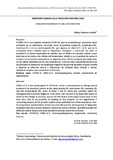Mostrar el registro sencillo del ítem
Inmunopatogenia de la infección por SARS-COV2
| dc.rights.license | http://creativecommons.org/licenses/by-nc-sa/3.0/ve/ | es_VE |
| dc.contributor.author | Salmen, Siham | |
| dc.date.accessioned | 2020-11-27T03:57:13Z | |
| dc.date.available | 2020-11-27T03:57:13Z | |
| dc.date.issued | 2020-10-26 | |
| dc.identifier.issn | 2244-7482 | es |
| dc.identifier.uri | http://www.saber.ula.ve/handle/123456789/47107 | |
| dc.description.abstract | El SARS-CoV-2 es el agente causal de COVID-19, que se caracteriza por presentar varias proteínas en su estructura, conocidas como la proteína espiga (S), membrana (M), envoltura (E) y de las nucleocápside (N), que algunas de ellas la S y la N, que en la actualidad tienen utilidad para el diagnóstico serológico y molecular. De ellas, la proteína S es objeto importante de estudio para el diseño de vacunas, debido a que participa en la unión a las células del hospedador, debido a su propiedad de unirse al receptor de la enzima convertidora de angiotensina 2 (ACE2) presente principalmente en las células epiteliales de las vías respiratorias. Conocer estas características del virus ha permitido el desarrollo de estrategias diagnosticas que han ayudado en gran medida a detectar la infección activa, y diferenciar las distintas fases clínicas e incluso identificar aquellos que resolvieron la infección. | es_VE |
| dc.language.iso | es | es_VE |
| dc.rights | info:eu-repo/semantics/openAccess | es_VE |
| dc.subject | COVID-19 | es_VE |
| dc.subject | SARS-Co-2 | es_VE |
| dc.subject | inmunopatogenia | es_VE |
| dc.subject | enzima convertidora de angiotensina | es_VE |
| dc.title | Inmunopatogenia de la infección por SARS-COV2 | es_VE |
| dc.title.alternative | Immunopathogenesis of SARS-COV2 infection | es_VE |
| dc.type | info:eu-repo/semantics/article | es_VE |
| dcterms.dateAccepted | 02-11-2020 | es |
| dcterms.dateSubmitted | 24-10-2020 | es |
| dc.description.abstract1 | SARS-CoV-2 is the causal agent of COVID-19, which is characterized by having several proteins in its structure, known as the spike protein (S), membrane (M), envelope (E) and the nucleocapsid (N), some of them S and N, which are currently useful for serological and molecular diagnosis. From them, the S protein is an important object of study for the design of vaccines, due to the fact that it participates in the union to the host cells, due to its property of binding to the receptor of the angiotensin 2 converting enzyme (ACE2) present mainly in the epithelial cells of the respiratory tract. Knowing these characteristics of the virus has allowed the development of diagnostic strategies that have greatly helped to detect the active infection, and differentiate the different clinical phases and even identify those that solved the infection. | es_VE |
| dc.description.colacion | 101-114 | es_VE |
| dc.description.email | salmensiham9@gmail.com | es_VE |
| dc.description.frecuencia | semestral | es |
| dc.identifier.depositolegal | ppi200802ME3759 | es |
| dc.publisher.pais | Venezuela | es_VE |
| dc.subject.facultad | Facultad de Medicina | es_VE |
| dc.subject.institucion | Universidad de Los Andes | es_VE |
| dc.subject.keywords | COVID-19 | es_VE |
| dc.subject.keywords | SARS-Co-2 | es_VE |
| dc.subject.keywords | immunopathogenesis | es_VE |
| dc.subject.keywords | angiotensin converting enzyme | es_VE |
| dc.subject.publicacionelectronica | Revista de Bioética Latinoamericana | es |
| dc.subject.seccion | Revista de Bioética Latinoamericana: Artículos | es_VE |
| dc.subject.thematiccategory | Medicina y Salud | es_VE |
| dc.subject.tipo | Revistas | es_VE |
| dc.type.media | Texto | es_VE |
Ficheros en el ítem
Este ítem aparece en la(s) siguiente(s) colección(ones)
-
Revista de Bioética Latinoamericana - Vol 025 Nº 1
Marzo-Agosto 2020


